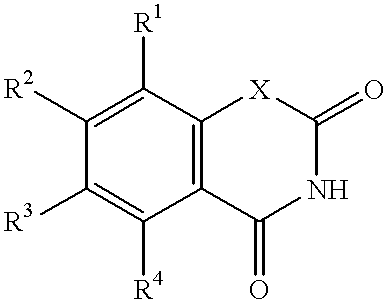Photothermographic recording material coatable from an acqueous medium
a technology of photothermographic recording and acqueous medium, applied in the field of photothermographic recording materials, can solve the problems of very inefficient production methods, and achieve the effect of excellent image-forming properties
- Summary
- Abstract
- Description
- Claims
- Application Information
AI Technical Summary
Benefits of technology
Problems solved by technology
Method used
Image
Examples
experiment d
EXPERIMENT D was carried out as described for EXPERIMENT C, except that the quantity of the 20% aqueous dispersion of BINDER 02 was increased from 1 g to 4.2 g.
Image-wise exposure and thermal processing
The photothermographic materials produced in experiments A, B, C and D of COMPARATIVE EXAMPLE 1 were then exposed to ultra-violet light through a test original in contact with the material in an Agfa-Gevaert.TM. DL 2000 exposure apparatus followed by heating on a heated metal block for 10 s at 95.degree. C. to produce a very good image with a high contrast and good sharpness. The quality of the images obtained was assessed qualitatively and awarded a numerical score between 0 and 5 where these values correspond to:
0=no image
1=a very weak image
2=a weak image
3=a moderate image quality
4=a good image
5=a very good image with high contrast and good sharpness
The photothermographic materials from EXPERIMENTS A, B, C and D all exhibited a noticeably increased optical density after coating and ...
experiment b
EXPERIMENT B was carried out as described above for EXPERIMENT A, except that the addition of the 5% solution of GELATIN 02 was omitted.
experiment c
EXPERIMENT C was carried out as described for EXPERIMENT B, except that the quantity of the 20% aqueous dispersion of BINDER 02 was increased from 1 g to 4.2 g.
Image-wise exposure and thermal processing
The photothermographic materials produced in experiments A, B and C of COMPARATIVE EXAMPLE 2 were then image-wise exposed and thermally processed as described for the photothermographic materials of COMPARATIVE EXAMPLE 1. The quality of the images obtained was assessed qualitatively as also described for the photothermographic materials of COMPARATIVE EXAMPLE 1.
The photothermographic materials from EXPERIMENTS A, B and C all exhibited a noticeably increased optical density after coating and drying. Image-wise exposure followed by thermal processing produced an increase in optical density, but only the photothermographic material of EXPERIMENT C exhibited any image discrimination and then only with poor contrast. The materials of EXPERIMENTS A, B and C were, therefore, awarded score of...
PUM
| Property | Measurement | Unit |
|---|---|---|
| wavelength | aaaaa | aaaaa |
| wave length | aaaaa | aaaaa |
| thickness | aaaaa | aaaaa |
Abstract
Description
Claims
Application Information
 Login to View More
Login to View More - R&D
- Intellectual Property
- Life Sciences
- Materials
- Tech Scout
- Unparalleled Data Quality
- Higher Quality Content
- 60% Fewer Hallucinations
Browse by: Latest US Patents, China's latest patents, Technical Efficacy Thesaurus, Application Domain, Technology Topic, Popular Technical Reports.
© 2025 PatSnap. All rights reserved.Legal|Privacy policy|Modern Slavery Act Transparency Statement|Sitemap|About US| Contact US: help@patsnap.com

